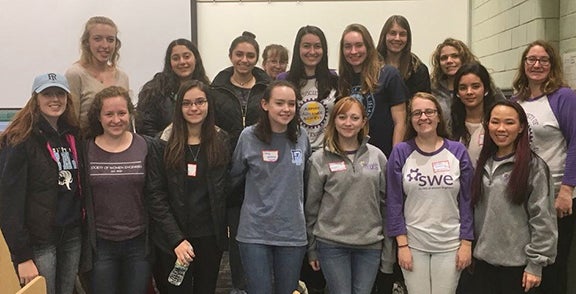KINGSTON, R.I. – Dec. 7, 2017 – Since 1994, the URI student chapter of the Society of Women Engineers has welcomed a group of girls from Girl Scouts of Rhode Island for “Badge Day.” Every year on the Kingston campus, the URI college students mentor the Junior Scouts, in grades 4 and 5, as they collaborate on science projects.
This year’s event brought together 17 URI students and 54 Scouts from seven local troops. Held on Nov. 18 in Pastore Hall, the students worked closely with their young counterparts as they rotated through six physics-related tasks in 25-minute intervals. The Scouts earned a “Physics is Phun!” patch, named for a two-dimensional physics engine.
“We developed six hands-on projects related to various aspects of physics,” said Susan Anderson, of the local chapter of the Society of Women Engineers. “We designed a patch and a program that the Girl Scouts, or any other youth group, can use.”
A lifetime member of the Girl Scouts, Anderson is a retired senior development engineer at Raytheon. She received an honorary doctorate from URI for bringing science and engineering to youth for more than 25 years.
According to URI-SWE faculty advisor Valerie Maier Speredelozzi, the activities change every other year.
“We switch up the activities so that a girl who is a Junior Scout can attend two years in a row and have a different experience at URI each time,” said Maier Speredelozzi.
While the Scouts rotated through the stations, their parents attended a presentation by Maier Speredelozzi, URI-SWE president Sydney Robinson and URI-SWE vice president Rachel Bellisle.
“We spoke to the parents about how they can be advocates for their daughters to go into the field of engineering,” said Robinson. “We talked about the different types of engineering and how it touches all aspects of our daily lives. The parents were encouraged to start a conversation about engineering with their daughters. Research shows that middle school is the time girls start losing interest in the science, technology, engineering and math fields.”
Judging by the reactions of the Scouts, working on fun science projects with the engineers may help invigorate or reinforce an interest in science and science-related fields.
“The Girl Scouts we worked with were so enthusiastic and really did an amazing job with the activities,” said Maeve Story, the engineering group’s outreach chair. “This event gives these girls a space to explore engineering, and each girl leaves excited about at least one thing they did.”
Here’s a description of the day’s activities:
Force & Motion
In pairs, the girls design and build a catapult to launch marshmallows at a target on the floor using recycled materials. They learn about projectile motion and how to angle it more accurately.
Electricity
The girls learn what makes a circuit complete, and then are given various fruit (lemons, potatoes, limes, pickles) to light an LED bulb using a penny, galvanized nail and alligator clip leads. They also build their own bristllebot they can take home with them.
Aeronautics
The Scouts are shown a brief video on tumblewing gliders and make their own using phonebook paper. They “fly” them by walking with a corrugated plastic lawn signboard or part of a cardboard box creating the air stream.
Optics
The girls learn about light and reflection by making a kaleidoscope from photo paper, wax paper, tissue paper and confetti. They also color a disk with the colors of the rainbow, and spin it on a skewer to make them “vanish,” as white combines all colors. If time allows, they make a disk where black lines spin into colors.
Acoustics
The Scouts learn about sound vibration by making a straw oboe. More noise is made with their “talking cup,” which is a plastic cup with string knotted through it and a wet sponge running along the string.
Space
The girls learn about astrophysics and the constellations by choosing a constellation on paper, putting holes through the stars with a pin, taping it to a tube, and flashing a light through the tube to the ceiling to display the “stars.” They also make a star wheel to take home and find the constellations each month.

